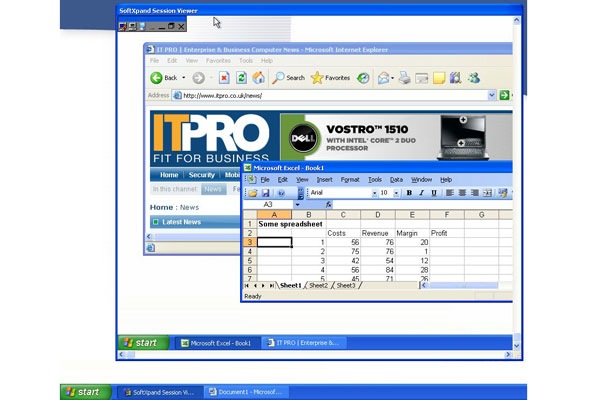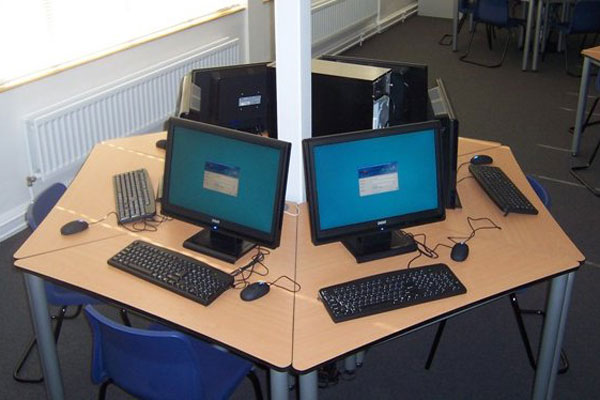Miniframe SoftXpand
It’s cheap, it’s green, but is it legal? Miniframe's unique approach to thin clients lets multiple users access a single Windows PC, but check your licences before you drive. (UPDATE! Yes, it's legal.)
SoftXpand cleverly exploits the fact that today’s PCs are over-specified for the tasks on which they spend most of their time, and demonstrates it by showing that a single PC is actually capable of supporting as many as eight concurrent users with acceptable performance. MiniFrame and software vendors need to clarify licensing issues but the system works well and offers real savings, though it is designed for budget-conscious users in a limited range of scenarios.


If you want to go green, or simply save money, thin clients make sense. Products like the Sun Ray 2 are low-powered computers equipped with a graphics card, network interface, audio, and just enough computing power to display a remote desktop. The snag: they are less powerful than real PCs, particularly for applications that use graphics intensively.
Enter MiniFrame's SoftXpand. The key feature is that each "thin client" is just a screen, keyboard and mouse. These are connected directly to a host PC by USB, or in the case of the screen plugged directly into a graphics card. The next surprise is that the server is running plain old Windows XP Professional. It is like using grown-up Terminal Server, but without the need for remote computers. All the clients are wired directly to a single PC.
Another way of looking at it is that MiniFrame has hacked Windows XP to remove some of its built-in restrictions. Out of the box, XP supports multiple user sessions, accessed by Fast User Switching, but only one can be active at a time. XP also support remote desktop, but only for one user at a time. With SoftXPand running, these limitations disappear. Up to 8 users can run active sessions simultaneously, and starting a remote desktop session from another computer does not interrupt the local sessions.
A quick overview of the setup process helps to make sense of the system. The starting point is a PC with more than one monitor port. Many graphics cards now support two monitors, so typically you need one card for every two users. Nvidia cards are preferred, though other brands are supported via a "safe" video mode that does not use hardware acceleration.
You also need a main USB hub, and for each user, a monitor, a further mini USB hub, keyboard and mouse, and a USB soundcard if audio is required. Everything is wired together, typically with the PC in the centre and workstations arranged around a table or along a wall. Clearly there are physical limitations. MiniFrame suggests a maximum length of 25 meters for VGA cables, and 20 meters for USB cables.
The next step is to use XP's control panel to configure each monitor to "extend my desktop". If this is a standalone installation, you also need to create a local user account for each user, or alternatively join the PC to a Windows domain. Now start SoftXPand. The system automatically starts a session and presents a login dialog on each monitor. Since all the USB devices are connected to the same PC, you need to press some magic keys to associate each keyboard, mouse and soundcard with the right session.
That's it. Users can now log on and get to work. In my tests, using a Core 2 Duo powered PC with 2GB RAM, the system was usable and responsive with four simultaneous users browsing the web and running Microsoft Office 2003.
Get the ITPro daily newsletter
Sign up today and you will receive a free copy of our Future Focus 2025 report - the leading guidance on AI, cybersecurity and other IT challenges as per 700+ senior executives
-
 ‘Phishing kits are a force multiplier': Cheap cyber crime kits can be bought on the dark web for less than $25 – and experts warn it’s lowering the barrier of entry for amateur hackers
‘Phishing kits are a force multiplier': Cheap cyber crime kits can be bought on the dark web for less than $25 – and experts warn it’s lowering the barrier of entry for amateur hackersNews Research from NordVPN shows phishing kits are now widely available on the dark web and via messaging apps like Telegram, and are often selling for less than $25.
By Emma Woollacott Published
-
 Redis unveils new tools for developers working on AI applications
Redis unveils new tools for developers working on AI applicationsNews Redis has announced new tools aimed at making it easier for AI developers to build applications and optimize large language model (LLM) outputs.
By Ross Kelly Published
-
 Google layoffs continue with "hundreds" cut from Chrome, Android, and Pixel teams
Google layoffs continue with "hundreds" cut from Chrome, Android, and Pixel teamsNews The tech giant's efficiency drive enters a third year with devices teams the latest target
By Bobby Hellard Published